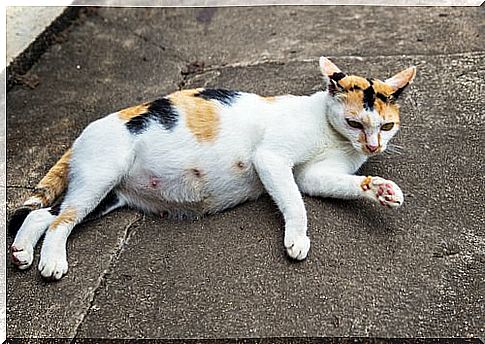Feline Pregnancy: What You Need To Know About

The keys to the feline pregnancy period are in the symptoms and gestures that cats present. The duration of pregnancy is just over two months.
If you think or have confirmed that your kitten is pregnant and want to give her the best during this period, we recommend that you read the following article. In it you will find detailed information about feline pregnancy.
Signs of Feline Pregnancy
When we think of a female’s pregnancy, we imagine the animal with a big belly. In the case of cats, this is visible after four weeks. Likewise, we can detect that a pregnancy is occurring due to several signs, both physical and behavioral:

1. Pink nipples
The cat’s nipples swell from the first moments of pregnancy. Sometimes this can also occur during heat, making it not a decisive sign.
However, typical of this condition is the color of the nipples becoming a more intense pink. You don’t have to be very observant to notice this, even with the animal’s coat on top.
2. Loss of appetite
If you have a kitten that loves to eat (not to call her a greedy) and she suddenly starts to leave food on her plate and shows no interest when you serve her kibble, it could be that she is pregnant.
Of course, you should take her to the vet to make sure it’s not an illness. In addition, the trip will be opportune, as the specialist will confirm what we want to know: if the cat is expecting puppies.
3. More sleep
It’s true that cats often sleep during the day and go out hunting or playing at night, even though they can also be active when there is sunlight. If your cat is pregnant, she will likely spend a lot of time sleeping or lying on the couch or bed.
In addition, another of the behavior changes during the gestation of the cats is that they do not play as much as they used to. They jump and run less, and objects don’t catch their attention as much as they used to.
4. Opposite behavior
This means that if your kitten was affectionate, it may become skittish, and vice versa. When they trust their owners a lot, pregnant cats get closer to them, seeking caresses and attention at all times.
However, be aware that the cat may become more scared, suspicious or nervous. This is more common in cats that used to live on the street and were recently rescued. In addition, she will likely distance herself from other animals that live in the house, including those with which she gets along well.
Feline pregnancy week by week
The reproduction of felines is similar to that of all mammals. The male’s sperm reach the female’s egg during copulation and within 5 days the nest is produced in the uterus.

During pregnancy
Feline pregnancy lasts from 64 to 67 days, a little over two months. The number of kittens per litter will depend on several factors. However, on average, a cat has between one and five kittens.
Between the first and third week, pregnancy is not very visible, as we mentioned. The heartbeat of babies can be seen on ultrasound from the 20th day of pregnancy.
Embryos are five centimeters long and seven grams in weight on day 33, but they need only ten days to double their size. That’s why from the first month of pregnancy, you can notice a swollen belly.
Between the fourth and fifth week, the mother may have nausea. Don’t worry though, this is normal and is due to hormonal changes in your body, such as with pregnant women.
As the kittens gain weight, the cat will also gain a little weight and may want to eat more than usual. It is very important to consult the veterinarian regarding the quantity and quality of food you will offer during this period, as the cat will be feeding herself and her kittens.
At around 45 days of gestation, puppies develop their muzzle and the coat that will cover them throughout life. A few days later, it is possible to detect the movement of the kittens in the mother’s womb.
After pregnancy
Delivery will take place around day 65, when babies weigh between 85 and 100 grams, and at least measure 10 centimeters. You will notice that the birth is close at least a week before. This is because the cat will look for a secluded, silent and peaceful place to give birth.
A good idea is to prepare a cardboard box with towels and blankets so that she feels comfortable and can give birth without any problems. On the day of birth, their intense meows and labored breathing will alert you to what is to come. Let her have her babies alone, but don’t be careless if a problem occurs, for example, if babies take too long to be born.









